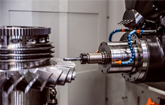
LONDON, Nov. 26, 2025 /PRNewswire/ -- Strategic Revenue Insights - The Heavy Machinery Advanced Materials market is entering a decisive phase of transformation, driven by rising demand for stronger, lighter, and more efficient materials that can withstand the rigorous demands of modern industrial environments. Heavy equipment manufacturers across construction, mining, agriculture, and energy are increasingly shifting toward next generation materials that elevate durability, operational efficiency, and environmental performance.
This shift is well documented in the latest industry intelligence published under Heavy Machinery Advanced Materials https://www.strategicrevenueinsights.com/industry/heavy-machinery-advanced-materials-market which continues to attract interest from both established players and emerging innovators. What is clear is that the market's momentum reflects a broader economic trend toward advanced engineering materials that reshape the way heavy machinery is produced, maintained, and optimized across its lifecycle.
Market Movements and Evolving Trends
The sector is evolving rapidly as industries push for materials that not only meet performance thresholds but also adapt to intensifying regulatory pressure and customer expectations. One major trend influencing the market is the increasing reliance on composites and high strength alloys in equipment that must operate under extreme loads and harsh conditions. Manufacturers are moving away from traditional metals when weight reduction, fuel efficiency, and longer operational life can be gained through advanced polymers or ceramic infused composites. This shift is accelerating as heavy machinery becomes more automated, more data driven, and more integrated into digital manufacturing ecosystems.
Sustainability is also reshaping material choices. Companies are actively looking for recyclable materials, lower carbon alternatives, and solutions that help reduce energy consumption during production. At the same time, customers in mining and construction are demanding equipment that lasts longer with reduced maintenance cycles. This is encouraging material developers to create formulations that resist corrosion, fatigue, and thermal degradation. As global supply chains adjust to geopolitical shifts and fluctuating raw material prices, the preference for adaptable and cost-efficient materials continue to strengthen. The overall result is a trend landscape defined by sustainability, operational performance, recyclability, and digital compatibility.
Browse the associated report:
https://www.strategicrevenueinsights.com/kr/industry/heavy-machinery-advanced-materials-market
https://www.strategicrevenueinsights.com/ja/industry/heavy-machinery-advanced-materials-market
https://www.strategicrevenueinsights.com/pt/industry/heavy-machinery-advanced-materials-market
https://www.strategicrevenueinsights.com/it/industry/heavy-machinery-advanced-materials-market
https://www.strategicrevenueinsights.com/es/industry/heavy-machinery-advanced-materials-market
https://www.strategicrevenueinsights.com/da/industry/heavy-machinery-advanced-materials-market
https://www.strategicrevenueinsights.com/de/industry/heavy-machinery-advanced-materials-market
https://www.strategicrevenueinsights.com/fr/industry/heavy-machinery-advanced-materials-market
New Directions in Advanced Material Technologies
Technological advancements are playing a central role in shaping the future of heavy machinery materials. Innovations in metallurgical processes have enabled the development of ultra-high strength steels that can endure extreme mechanical stress without increasing equipment weight. Similarly, breakthroughs in powder metallurgy and additive manufacturing allow manufacturers to design components with complex geometries that improve performance and reduce material waste.
Composite materials are benefitting from rapid innovation as well. Carbon fiber reinforced polymers and hybrid composites are now being engineered with specific mechanical properties that align with individual application requirements. These materials provide higher fatigue resistance, thermal stability, and extended service life in industries where downtime is costly and equipment performance directly affects output.
Automation and smart fabrication processes are another major catalyst. Robotic welding, digital twins, and real time process monitoring are improving the precision and consistency of material production. These technologies make it possible to integrate advanced materials into machinery without compromising structural integrity or increasing operational risk. Layered on top of this is the emergence of smart materials that adapt to environmental conditions, providing self-healing capabilities, enhanced vibration damping, or improved thermal management. While still early in adoption, these innovations hint at a future where machinery becomes far more resilient and responsive.
Environmental Pressures and Sustainability Challenges
Environmental concerns are becoming a central factor in material selection, manufacturing decisions, and investment strategies. Heavy machinery remains closely scrutinized for its contribution to emissions, resource depletion, and end of life waste. Advanced materials are expected to address at least part of this challenge, but the path is complex.
One sustainability challenge involves the energy intensity of producing high performance materials such as carbon fiber composites. Studies indicate that manufacturing carbon fiber can require up to five times more energy per kilogram than producing steel. This creates tension between performance benefits and environmental impact. Another challenge is the recyclability of composite materials. While metals are relatively easy to recycle at scale, large format composites used in heavy machinery often end up in landfills due to the difficulty of separating fiber and resin.
Despite these pressures, the industry is launching several mitigation initiatives. Closed loop recycling programs for metals are expanding, driven by regulatory incentives and cost efficiencies. Material developers are also experimenting with bio-based polymers and low temperature curing resins that reduce energy use during production. In parallel, major OEMs are setting ambitious environmental goals. Several leading manufacturers are committing to reduce lifecycle emissions by more than 30 percent by 2030 and are actively adjusting procurement strategies to prioritize lower carbon materials. This push is creating opportunities for suppliers that can demonstrate measurable sustainability impact supported by verifiable data.
Market Analysis and Structural Outlook
The Heavy Machinery Advanced Materials market was valued at 45 billion dollars in 2024 and is projected to reach 75 billion dollars by 2033, reflecting a compound annual growth rate of 5.5 percent over the forecast period. The largest concentration of demand comes from construction and mining equipment, where durability and equipment uptime are directly tied to financial performance. Agriculture and energy sectors are also expanding their use of advanced materials, particularly in high wear components, chassis structures, and energy intensive machinery.
A closer look at regional distribution shows that Asia Pacific is emerging as the fastest growing market, supported by rapid industrialization, infrastructure expansion, and government backed manufacturing initiatives. North America and Europe maintain strong shares due to their focus on innovation, engineering excellence, and sustainability aligned regulations. Latin America and the Middle East are growing steadily, driven by investments in mining, oil and gas, and infrastructure modernization.
The competitive landscape is dominated by leading material producers such as ArcelorMittal, BASF SE, Dow, 3M Company, Solvay, and DuPont. These companies are expanding their material portfolios, funding research into high performance composites, and pursuing strategic acquisitions to strengthen market presence. At the same time, regional players are securing opportunities by offering specialized solutions tailored to local industrial requirements. The rise of digital procurement systems and predictive maintenance tools is also reshaping how materials are selected, evaluated, and integrated into heavy machinery designs.
Key drivers sustaining market growth include the need for cost efficient machinery maintenance, higher demand for extreme condition resistance, and global movement toward resource optimization. Constraints include high production costs for certain advanced materials, limited recyclability of some composites, and regulatory complexities that vary significantly across regions.
Future Directions and Long-Term Industry Outlook
The next decade will likely redefine how heavy machinery is designed, built, and maintained. One major influence will be regulations pushing for lower emissions, cleaner production processes, and responsible sourcing. These policies are expected to accelerate the adoption of lightweight materials, recycled metals, and alternative composites that reduce carbon intensity. Another factor shaping the future is digital engineering, where simulation tools, predictive analytics, and AI driven material modelling will enable faster and more precise development cycles.
Manufacturers will increasingly integrate multimaterial designs that balance strength, cost, and environmental performance. This approach is already gaining traction in high load components used in mining trucks, excavators, and industrial loaders. Additionally, additive manufacturing is expected to unlock new possibilities by enabling on site production of specialized parts, reducing inventory requirements, and shortening maintenance lead times.
A demographic shift is also influencing demand. Emerging economies across Asia, Africa, and Latin America are building infrastructure at unprecedented speeds, creating sustained demand for heavy equipment. As these regions scale industrial output, the need for advanced materials will grow in parallel. This expansion will likely intensify competition among suppliers while encouraging innovation that reduces cost barriers and improves environmental compliance.
Another forward-looking trend is the integration of circular economy principles in heavy machinery material design. Companies are exploring material passports, modular components, and easier disassembly to support end of life recovery and reuse. These practices have the potential to reduce lifecycle costs while aligning with environmental expectations from governments, investors, and industrial customers.
Reflective Summary and Strategic Perspective
Heavy Machinery Advanced Materials are becoming the backbone of industrial progress, shaping how heavy equipment performs, lasts, and adapts to evolving global demands. As industries pursue higher efficiency, greater sustainability, and improved performance, the role of advanced materials will grow even more central. The coming years will reward companies that innovate in material science, optimize production techniques, and embrace environmentally responsible practices. For readers seeking deeper insights, related sector intelligence and extensive data driven research are available at Strategic Revenue Insights https://www.strategicrevenueinsights.com where ongoing analysis covers market evolution, investment trends, and forward looking opportunities across industrial and heavy industry domains.
Related Reports:
https://www.strategicrevenueinsights.com/industry/advanced-lubricants-for-heavy-machinery-market
https://www.strategicrevenueinsights.com/industry/automated-heavy-duty-truck-market
https://www.strategicrevenueinsights.com/industry/automotive-glass-for-heavy-commercial-car-market
https://www.strategicrevenueinsights.com/industry/battery-of-ev-bus-and-heavy-duty-trucks-market
https://www.strategicrevenueinsights.com/industry/battery-swap-heavy-trucks-market
https://www.strategicrevenueinsights.com/industry/bias-heavy-duty-tires-market
https://www.strategicrevenueinsights.com/industry/centrifugal-heavy-duty-slurry-pumps-market
https://www.strategicrevenueinsights.com/industry/cng-heavy-duty-truck-market
https://www.strategicrevenueinsights.com/industry/commercial-heavy-duty-washing-machines-market
https://www.strategicrevenueinsights.com/industry/electric-commercial-heavy-vehicle-market
https://www.strategicrevenueinsights.com/industry/electric-heavy-vehicle-market
https://www.strategicrevenueinsights.com/industry/exhaust-manifolds-for-heavy-duty-trucks-market
About Us:
Strategic Revenue Insights Inc., a subsidiary of SRI Consulting Group Ltd, empowers organizations worldwide with data-driven market intelligence. Headquartered in London, United Kingdom, we deliver syndicated research reports, tailored consulting solutions, and actionable insights that equip clients to make confident, future-focused strategic decisions.
Our team of seasoned analysts—based in London and connected globally—continuously tracks markets, identifies emerging trends, and uncovers growth opportunities to support long-term client success. As part of SRI Consulting Group Ltd, we are committed to accuracy, clarity, and practical relevance, helping businesses navigate competitive landscapes, optimize strategies, and accelerate revenue growth.
By combining rigorous research methodologies with deep industry expertise, Strategic Revenue Insights Inc. provides organizations with a comprehensive market perspective that drives measurable results and sustained competitive advantage.
Media Contact:
Company Name: Strategic Revenue Insights Inc.
Contact Person: Ashwani
Email: [email protected]
Phone: +44 7877403352
Address: Suite10 Capital House 61 Amhurst Road, E8 1LL
City: London
State: London
Country: United Kingdom
Website: www.strategicrevenueinsights.com
Website: www.strategicpackaginginsights.com
Website: www.sriconsultinggroupltd.com
Logo: https://mma.prnewswire.com/media/2826292/Strategic_Revenue_Insights_Logo.jpg
SOURCE Strategic Revenue Insights





Share this article